
Polarizer on sensor image.
Sony provides
- Four-Directional Polarizer formed on chip
- Global shutter function
- High frame rate
- ROI mode, Trigger mode on their CMOS Sensor.
Sony Semiconductor Solutions’ polarization sensor can capture a four directional polarization image in one shot by the four directional polarizer (given below). It can calculate the direction and degree of polarization (DoP) based on the intensity of each directional polarization. Together with subsequent signal processing, it can capture the polarization information in real time.

To know more about the usage of these sensors on Machine vision cameras for different application areas in Vision, we need to understand some basics of polarization.
What is polarization?
Light has physical elements : brightness (amplitude), color (wavelength) and polarization (vibration direction). Lights from the Sun or fluorescent lamps vibrate in various directions and is called unpolarized light.
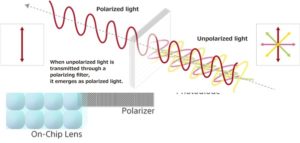
Polarization was achieved by applying Polarized filters on the lens or on the light to get polarized light hitting the sensor of the Machine vision camera
The most common method of polarization involves the use of a Polaroid filter. Polaroid filters are made of a special material that is capable of blocking one of the two planes of vibration of an electromagnetic wave.
A Polaroid serves as a device that filters out one-half of the vibrations upon transmission of the light through the filter. When unpolarized light is transmitted through a Polaroid filter, it emerges with one-half the intensity and with vibrations in a single plane; it emerges as polarized light.
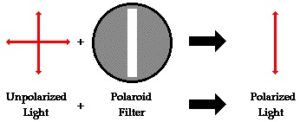
The filter does not distort the shape or dimensions of the object; it merely serves to produce a dimmer image of the object since one-half of the light is blocked as it passed through the filter.
Unpolarized light can vibrate in multitude of directions. Hence while applying filters multi directions or different angle is always an advantage and need to address many applications.
Sony’s CMOS sensor introduced has several different angle polarizer formed on chip
Polarization has two physical information, which are the degree of polarization and the direction of polarization. This information can be used for various applications such as surface scratch detection, particle inspection, distortion and shape recognition which has traditional been difficult to detect.
Degree of Polarization (DoP)
The light is reflected by the surface of the object in polarized and unpolarized lights. The DoP of the reflected light depends on the surface condition (material, color, roughness etc.) and the angle of reflection.


Normal Image Polarized Image (Degree of Polarization)
In the Degree of Polarization image above, the white is high polarization and black is low polarization. Hence, the stitch is easily visible due to the difference in the degree of polarization of the thread and leather.
Polarization Direction
Polarization direction provides the direction information of reflected plane of an object.
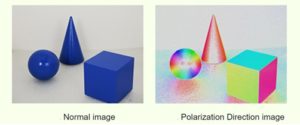
The direction of polarization image shows the angle of the polarization direction in color using HSV color mapping.
In this example, the upper side of the cube is highlighted in light blue meaning that the angle of the polarization direction is 90 degree (according to below standard).
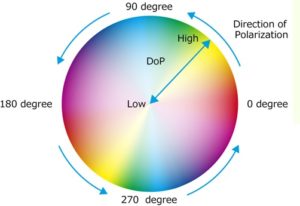
Other examples:
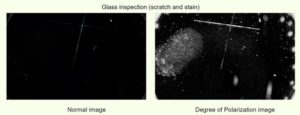
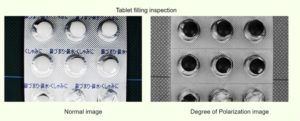
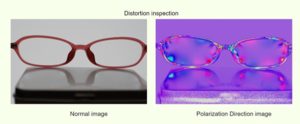

Many Machine vision camera companies have used the SONY chip mentioned in this article to release Polarization machine vision cameras in their existing product line.
Teledyne DALSA has released this in their NANO series on GigE interface whose info can be had from https://www.teledynedalsa.com/en/learn/knowledge-center/polarization-imaging/ and Pixelink – a Navitar Company has released their Machine vision cameras on USB 3 platform whose info can be had from https://pixelink.com/products/industrial-cameras/usb-30/pl-d755mu-pol/
Teledyne DALSA also has introduced Polarized Machine vision cameras in their Line Scan segment.

In general, In machine vision, it can be used to detect stress, inspect objects, reduce glare from transparent objects, and enhance contrast for objects that are difficult to distinguish otherwise.
Online Solutions (Imaging) Pvt. Ltd., Chennai India can provide total solutions for related machine vision applications. Please visit us at www.onlsol.com
Note: The above article is a collection from various web sites, manufacturers and distributors / integrators of Polarization Imaging Technology. If any company/individual finds any ownership of contents – they can let us know at [email protected] to either change or remove the contents. Article is provided only for the information purposes and facts can be cross verified by the readers.


